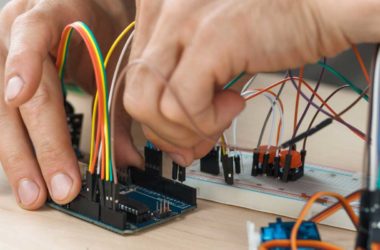Ever wondered how your watch keeps time so accurately? The answer lies in quartz crystals. Despite their small size, quartz crystals play a massive role in modern technology. They’re the overlooked heroes behind the precision of our clocks, reliability of our devices, and much more.
To find out how these tiny wonders work, we spoke to Nick Amey, the Engineering Director at IQD, a frequency and timing company that produces quartz crystal oscillators. Since 1973, IQD has been a global leader in frequency control, serving customers in more than 80 countries. They offer a wide range of frequency products, from commercial-grade to high-reliability solutions for industrial and automotive sectors. IQD is a key member of Würth Elektronik, a top European passive components provider.
A Little Bit about Nick…

Nick has been with IQD for 18 years, starting as a repair engineer in 2005. Now the Director of Engineering, Nick oversees various technical teams, including test, R&D, and software development, during a phase of rapid growth. The focus is on nurturing the right culture and ensuring continued success.
IQD, celebrating its 50th year, was founded by Hugh Robinson, who transitioned into producing crystals and oscillators due to difficulties sourcing reliable timing components. In the late ’80s and early ’90s, IQD became recognized as a global leader. IQD’s Crewkerne laboratory in the UK is pivotal for customer support, addressing queries, specialised tests, and customer reassurance.
The Interview: In-Depth Discussion on Quartz-Based Timing Devices
Q1: What makes quartz crystals unique and what is their role in consumer electronics?
All the products that we offer have a piece of quartz inside. That’s the fundamental thing that makes the timing effect. And the reason that it’s used is because it has this effect called the piezoelectric effect. This is because quartz is made of silicon oxide, and its atomic structure behaves in a way that when you apply physical pressure, it moves negative ions in one direction and positive ions in the opposite direction. And conversely, if an electrical charge is put across a lump of quartz, it will pull positive ions in one direction, negative ions in another direction, and that will cause a physical change of shape. When I say physical, we’re talking on the atomic level here. So it’s teeny weeny distances. But that coupling between electrical and mechanical motion is quite rare. It was first discovered in about 1880, I think, by the Curie brothers. They were the first people that studied the piezoelectric effect. There are a few different things that have that effect but quartz crystals are the main one that is solid enough to be produced into something. The experiments happened on different kinds of salts but they crumble a little bit and it’s not possible to make long-term electronic devices out of it.
Q2: Are there any industries or appliances that really benefit from using this piezoelectric effect that is present in quartz?

We use it in the timing industry. The process involves shaping the physical lump of quartz so it has one specific resonant frequency. If you’re not used to the thought, you might have come across resonant frequencies in a wine glass. If you’ve got a nice wine glass and you tap it and it vibrates, it’s oscillating. It’s to do with the diameter of the top of the glass and the elastic constants of the glass itself. It rings and it makes one single frequency that is really pure and clear and it’s the same concept with quartz. We try to make a shape where there is one frequency that’s really pure and that will vibrate at. The impedance of all the other frequencies is very high, so it really doesn’t like them.
That’s the physical frequency that you’ve managed to produce there. So, now I put the quartz into an electrical circuit, we plate bits of silver on either side of the quartz to make electrodes and connect that into the feedback loop of an amplifier. So the amplifier when you first power it up, amplifies the white noise, the Johnson/Flicker Noise that’s on the copper of the PCB on the input or other electrical circuitry. So you’ve got a range of frequencies that are being amplified coming out the other side, you feed that back through the quartz and the quartz then says “there’s one physical frequency that I really enjoy vibrating at”. So that’s the one that it allows to pass through and all the other frequencies that it’s seeing it then blocks, because it’s got very high impedance for those other frequencies.
So then you come back through the quartz and back into the input of the amplifier, with just that single frequency. And after a couple of milliseconds of power up you end up with a sine wave coming out the other side, that’s defined by the physical shape of the quartz. So it’s like a coupling between electrical and physical motion that is really interesting here.
Q3: How do you pick the perfect crystal for a specific appliance? Are there multiple types of crystal that could be used for certain things?
So, the piezoelectric effect in quartz is produced in different planes through the crystallographic axis and the secret is to try and destroy the vibration mode in all the planes, except one. So, our job is to try and design a shape where there’s just one mode of vibration that’s really clear. A lot of the research on this was done in the ‘70s and ‘80s, there’s loads of white papers on it from a really interesting time. But then when I came in, it was pretty much established that for 1 MHz, through to about 30 MHz and now pushing up to 60 or 80 MHz, we use the AT-cut. So that’s 35°15′ cut from the crystallographic axis. Then it’s a bulk acoustic wave, so we’re plating on either side of that. Finally, you end up with a single mode of vibration and all the other modes are nicely suppressed.
Q4: The quartz revolution started in the 60s in Japan when Seiko introduced Astron, the world’s first quartz wristwatch. Since the 60s the technology has improved so the frequencies are better now and the crystals are getting smaller and smaller. Hence the question then, does size matter?
This is a good question. The big research that’s been going on for the last 10, 15 years has been how to make it smaller. Everything in electronics has gotten smaller and smaller so we have to keep pace with that.
It is miniaturisation…
Yes, miniaturisation and wearable stuff! If I look at an iPhone now and you think about how much technology that your iPhone’s got in it – It’s incredible. With quartz crystals because it is physically vibrating we seal it inside a vacuum package, it’s tested to 10 to the minus eight backing level, which is a very, very high vacuum. So, actually one of the problems that we had in miniaturisation is how to make the package small enough, and still be able to seal it. There has been a lot of work on the ceramics that we’ve done. About 15 years ago, they changed the ceramic structures to try and improve the brittleness of the edges as it got too small and started to crumble as it came out the moulds.
But, from a customers’ perspective, it’s a good point. Smaller crystals have higher resistance values so I talked about how at the resonant mode there’s a very low impedance compared to all the other frequencies and that’s how it passes it back on the feedback loop. As the crystals get smaller the impedance at the resonant frequency starts to rise. This is because the size of those two, silver electrodes and the size of the area where the signals passing through the crystal have become smaller so therefore it’s got a higher resistance even at the resonant frequency. The higher resistance means within that feedback loop the gain of the amplifier has to be more than the resistance of the feedback loop, so the crystal is the feedback loop. This means if the crystal’s resistance is rising there’s a chance that the amplifier might not have enough gain to overcome the resistance of the crystal and then you won’t have a stable oscillation.
Q5: What is the difference between watch crystals and crystals for real-time clocks?
Watch crystals are tuning fork shapes (the name comes from the mechanism as they shape like a tuning fork), rather than the AT-cut crystal, mentioned earlier on. It’s got two dynes which are powered with electrode connections at the base. But the electrodes travel up each of the dynes and they vibrate like a tuning fork – the two dynes are oscillating towards each other and away from each other at the same time. The reason that’s done is because It takes a very small amount of energy to kickstart that into vibration and then mechanically you’ve got quite a large mass at the end. So like a pendulum it kind of keeps vibrating for a long time which means that you can run it on very, very low current draw.

Q6: Could you tell us more about oscillators for smartphones and oscillators for basic clocks – how do they differ?
A basic clock, such as the one used in home appliances, e.g. microwaves, normally doesn’t show seconds so it only needs to be accurate to about one minute every six months. Another aspect is that your smartphones have to maintain synchronisation with a network and that’s a different game altogether. There’s a stratum system that defines what level of accuracy a clock has got to be within the network and there are definitions in the ITU (International Telecommunication Union) Standards for how far out of time something is allowed to go before the network will reject it and so you’re not a valid part of the system here. Then there are specifications for holdover so if the clock can’t synchronise repeatedly against the rest of the network, how far is it allowed to drift in and in what time period before it has to be pulled back in. There are some pretty stringent requirements for that kind of stuff. The handsets are at one end and then you work through the network right up to the stratum one clocks, which you have got to be able to maintain accuracies within microseconds or nanoseconds of UTC for their life without losing anything.
Q7: Would you say the process of developing and designing a quartz oscillator is complicated, especially for people that are still learning or just started in the industry?
Recently, what we found is that a lot of the engineers are coming out of university and they’re incredibly clever people but they studied digital electronics and actually this bit of the circuit is an analog circuit so there’s often a little bit of lack of knowledge there. It is also quite a specialist subject, how to get an oscillator to oscillate isn’t something that everybody studied. It’s probably not the most exciting thing, there is no course in that at university but also there’s some equipment that we use here that you probably wouldn’t need to buy yourself. We would measure the crystals resonant frequency on a network analyser, that’s specifically set up to measure crystal resonant frequencies that gives us a baseline of what the frequency should be, if the CL is correct and then we can measure it on the customers’ PCB and see if there’s an offset between the two. Buying that equipment can be costly, but no-one probably ever needs it except for that measurement so it is better to use our service as we’ve got a few of them because we use them all the time.
Q9: Do these devices get worse or age over time?
I’ve been there for 18 years and I’ve never had a part fail because it’s just too old. It doesn’t happen, they keep working forever. There is an ageing effect which is what we need to talk about here. So crystals will change frequency a small amount over their lifetime. Predominantly that’s a logarithmic decay curve and you see a lot more ageing in the first year than you do over the lifetime. The amount of ageing reduces over the time span and that’s caused by two factors. There’s the outgassing of the epoxy – so when we mount the crystal inside the package, we use a silver loaded epoxy glue and epoxy, as you know, when you’ve used them yourself at home they have a smell so they’re outgassing, they’ve given out gas. That gas pollutes the purity of the cavity where the crystal is stored. So the silver electrodes begin to tarnish a little bit as it reacts with the gases that are coming off. It’s very small and obviously in the manufacturing stage, we use things like vacuum ovens to try and extrapolate as much of that as possible but there’s always a residue.
The other effect is stress relaxation so the quartz itself is a lump of rock and then we plate it with an electrode on either side. When we plate it, we hold it in a mask. Sometimes that mask can grab the quartz in a little tiny way and put a bit of flexure on it, then when you plate the silver on it and take it out of the mask, the silver ends up with the flexure as the flexure on the quartz relaxes and then over time that inconsistency and in the stress is begins to relax a little bit and that will cause a small change in frequency. I mean microscopic amounts here. This is a minimal effect but that’s the cause of ageing. Meaning that maybe on a standard quartz crystal, perhaps in one, two, three PPM ageing. And then it will diminish down to something that’s almost inconceivable.
One of the offers we do for our customers that have experienced real critical problems is to decrease the ageing by putting it in an oven in an elevated temperature that can be run for 30 days. We take that first bit of the logarithmic decay curve away before it is given to the customer.
Q9: What would you say is the most important in choosing the right crystal?

So the first thing we ask customers is:
- What volumes do you want?
- What price are you expecting to pay for this?
- What product lifetime are you looking for?
With those things in mind we can then move into the technical discussion, such as the stability, frequency and the temperature range the person wants to work over, etc. And then the base frequency that one wants to use. We tell customers: “if you run it at lower frequency, normally you’re executing some piece of code, where you need the time to be synchronising the code events that are happening inside your processor”. If a customer runs it at a lower frequency, their code can’t execute so quickly, but the CMOS switching is a lot slower. So therefore, overall, their device will draw a lot less current and in a product like a microwave or washing machine that’s fine because they probably don’t need to execute complex bits of code but in a product like a smartphone, for example, they do need to execute code extremely fast. So they probably need to run a higher frequency for that.
Another thing that needs to be considered here is how far away from that base frequency do you need to stay within so what’s the overall frequency stability that you’re looking for. Again, if you’re looking at something like a washing machine or a microwave where there’s no communication going on, you’re simply executing a piece of code, actually, you can be pretty far away from that base frequency, before it’s going to stop working.
Q10: Jumping to the future now, are there any cutting edge technologies that you’re working on or you’re excited about?
Yes, but I can’t talk about them! (laughs)
I can predict that in around six months from now, everything will be even smaller with even lower current draw and even lower phase noise. That’s always been the golden standard – we want less current draw, we want smaller size, we want less phase noise and more stability.
Q11: If we are focusing on the present, what do you think makes IQD stand out and why should customers trust your brand and the products you offer?
IQD has been around for 50 years so we have 50 years’ experience in this area. We’ve got a team outside my office here with eight people who are dedicated to customer support. They’re all technical specialists with 20 years’ experience that are mainly talking about oscillator design and they’re dedicated to helping customers.
Downstairs, here in Crewkerne, we’ve got a laboratory where there is a lot of equipment that we design and build ourselves. Primarily, we use that equipment for reliability testing, for final tests and then for customer screening. But along with that, what we find is, because we design and build most of the equipment ourselves, all the problems that customers get are the same problems that we have when we are testing it ourselves. All the problems that customers have, we have faced personally here so we see customers come in with stuff and one of the engineers around will recognize that issue as he dealt with it before. We can give that first-hand experience on how to resolve these issues to customers.











